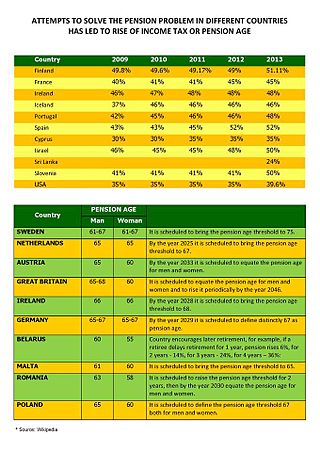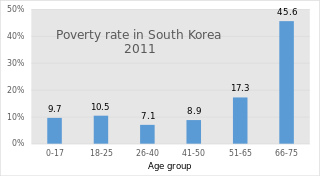Related Research Articles

A pension is a fund into which amounts are paid regularly during an individual's working career, and from which periodic payments are made to support the person's retirement from work. A pension may be:
A pension fund, also known as a superannuation fund in some countries, is any program, fund, or scheme which provides retirement income.

Welfare, or commonly social welfare, is a type of government support intended to ensure that members of a society can meet basic human needs such as food and shelter. Social security may either be synonymous with welfare, or refer specifically to social insurance programs which provide support only to those who have previously contributed, as opposed to social assistance programs which provide support on the basis of need alone. The International Labour Organization defines social security as covering support for those in old age, support for the maintenance of children, medical treatment, parental and sick leave, unemployment and disability benefits, and support for sufferers of occupational injury.
Unemployment benefits, also called unemployment insurance, unemployment payment, unemployment compensation, or simply unemployment, are payments made by authorized bodies to unemployed people. In the United States, benefits are funded by a compulsory governmental insurance system, not taxes on individual citizens. Depending on the jurisdiction and the status of the person, those sums may be small, covering only basic needs, or may compensate the lost time proportionally to the previous earned salary.
Income tax in the Netherlands is regulated by the Wet inkomstenbelasting 2001.
Social welfare, assistance for the ill or otherwise disabled and the old, has long been provided in Japan by both the government and private companies. Beginning in the 1920s, the Japanese government enacted a series of welfare programs, based mainly on European models, to provide medical care and financial support. During the post-war period, a comprehensive system of social security was gradually established. Universal health insurance and a pension system were established in 1960.
A private pension is a plan into which individuals privately contribute from their earnings, which then will pay them a pension after retirement. It is an alternative to the state pension. Usually, individuals invest funds into saving schemes or mutual funds, run by insurance companies. Often private pensions are also run by the employer and are called occupational pensions. The contributions into private pension schemes are usually tax-deductible.
In France, pensions fall into five major divisions;
Pensions in Spain consist of a mandatory state pension scheme, and voluntary company and individual pension provision.
India operates a complex pension system. There are however three major pillars to the Indian pension system: the solidarity social assistance called the National Social Assistance Programme (NSAP) for the elderly poor, the civil servants pension and the mandatory defined contribution pension programs run by the Employees' Provident Fund Organisation of India for private sector employees and employees of state owned companies, and several voluntary plans.
The Swiss pension system rests on three pillars:
- the state-run pension scheme for the aged, orphans, and surviving spouses ;
- the pension funds run by investment foundations, which are tied to employers ;
- voluntary, private investments.
The Pension Program for the Elderly (PPE) is a safety net, noncontributory pension program administered by the federal Secretariat of Social Development (SEDESOL) in Mexico. The program aims to expand the schemes of universal social security, by providing financial support and social protection to people 65 or older who a) do not benefit from retirement or contributory pension plans or b) receive income from retirement plans or contributory pension programs that does not exceed a certain amount determined by SEDESOL.

There are various types of Pensions in Armenia, including social pensions, mandatory funded pensions, or voluntary funded pensions. Currently, Amundi-ACBA and Ampega act as the mandatory pension fund managers within Armenia.
This article is intended to give an overview of pensions in the Netherlands.
Compared to other liberal democracies, Ireland's pension policies have average coverage, which includes 78 percent of the workforce, and it offers different types of pensions for employees to choose from. The Irish pension system is designed as a pay-as-you-go program and is based on both public and private pension programs.

South Korea's pension scheme was introduced relatively recently, compared to other democratic nations. Half of the country's population aged 65 and over lives in relative poverty, or nearly four times the 13% average for member countries of the Organisation for Economic Co-operation and Development (OECD). This makes old age poverty an urgent social problem. Public social spending by general government is half the OECD average, and is the lowest as a percentage of GDP among OECD member countries.
Pensions in Denmark consist of both private and public programs, all managed by the Agency for the Modernisation of Public Administration under the Ministry of Finance. Denmark created a multipillar system, consisting of an unfunded social pension scheme, occupational pensions, and voluntary personal pension plans. Denmark's system is a close resemblance to that encouraged by the World Bank in 1994, emphasizing the international importance of establishing multifaceted pension systems based on public old-age benefit plans to cover the basic needs of the elderly. The Danish system employed a flat-rate benefit funded by the government budget and available to all Danish residents. The employment-based contribution plans are negotiated between employers and employees at the individual firm or profession level, and cover individuals by labor market systems. These plans have emerged as a result of the centralized wage agreements and company policies guaranteeing minimum rates of interest. The last pillar of the Danish pension system is income derived from tax-subsidized personal pension plans, established with life insurance companies and banks. Personal pensions are inspired by tax considerations, desirable to people not covered by the occupational scheme.

Public pensions in Greece are designed to provide incomes to Greek pensioners upon reaching retirement. For decades pensions in Greece were known to be among the most generous in the European Union, allowing many pensioners to retire earlier than pensioners in other European countries. This placed a heavy burden on Greece's public finances which made the Greek state increasingly vulnerable to external economic shocks, culminating in a recession due to the 2008 financial crisis and subsequent European debt crisis. This series of crises has forced the Greek government to implement economic reforms aimed at restructuring the pension system and eliminating inefficiencies within it. Measures in the Greek austerity packages imposed upon Greek citizens by the European Central Bank have achieved some success at reforming the pension system despite having stark ramifications for standards of living in Greece, which have seen a sharp decline since the beginning of the crisis.
Cyprus is a high income country with a well established and extensive welfare system. The Social Insurance Scheme ensures access to healthcare, income support, and pensions, with mandatory contributions for all employees and employers. Income support is means tested on the basis of total family income and assets, which often places the burden of care on the family unit before the state provides assistance. There is also an obligation to seek work. The pension system is fairly comprehensive, yet may still leave some in the private sector unsupported.
South Korea introduced its Basic Old-Age Pension in 2008 as part of its pension system. According to the Ministry of Health, Welfare and Family Affairs, the Basic Old-Age Pension is "designed to enhance welfare of the elderly by providing a monthly pension payment to the elderly in need." The pension was intended to benefit workers contributing to the National Pension Scheme.
References
- ↑ World Social Protection Report 2017–19: Universal social protection to achieve the Sustainable Development Goals. International Labour Office. 2017. pp. XXIX. ISBN 978-92-2-130016-8.
{{cite book}}: CS1 maint: date and year (link) - ↑ Blake, David (2006). Pension Economics. Hoboken, NJ: John Wiley. ISBN 0-470-05844-7.
- 1 2 "Social Security History". www.ssa.gov. Retrieved 2019-04-08.
- ↑ Wilensky, Harold L. (2002). Rich democracies : political economy, public policy, and performance. Berkeley: University of California Press. ISBN 9780520928336. OCLC 52843450.
- ↑ "Social protection in older age | Pension watch". www.pension-watch.net. Retrieved 2019-04-08.
- ↑ Roser, Max; Ortiz-Ospina, Esteban (2016-10-18). "Government Spending". Our World in Data.
- ↑ Bank, The World (1994-09-30). "Averting the old age crisis : policies to protect the old and promote growth". pp. 1–436.
- ↑ World Bank. (2008). The World Bank Pension Conceptual Framework. Retrieved from: https://documents1.worldbank.org/curated/en/389011468314712045/pdf/457280BRI0Box31Concept1Sept20081pdf.pdf
- ↑ "What is Social Security? | National Academy of Social Insurance". www.nasi.org. Retrieved 2019-04-08.
- ↑ CICHON, Michael, et al. Financing social protection. International Labour Organization, 2004.
- 1 2 Ministry of Labour and Social Affairs (2024-03-16). "Pension Insurance". pp. 1–8.
- ↑ Shang, Baoping (8 March 2014), "Chapter 4. Pension Reform and Equity: The Impact on Poverty of Reducing Pension Benefits", Equitable and Sustainable Pensions, International Monetary Fund, ISBN 978-1-61635-950-8 , retrieved 2024-04-25
- ↑ Willmore, Larry (2012). "Types of Social Pension" (PDF).
- ↑ "Social protection for older persons: Policy trends and statistics 2017–19" (PDF). International Labor Office. 2019.
- ↑ "State Pension". life in denmark.dk. Retrieved 2024-04-20.
- ↑ "Pensions at a Glance 2023" (PDF). OECD. 2022. p. 2. Retrieved 20 April 2024.
- 1 2 3 "State Pension". life in denmark.dk. Retrieved 20 April 2024.
- ↑ "Pensions at a Glance 2023" (PDF). OECD. 2022. p. 2. Retrieved 20 April 2024.
- ↑ "Pensions at a Glance 2023" (PDF). OECD. 2022. p. 3. Retrieved 20 April 2024.
- ↑ H. Villarreal y A. Macías, “El sistema de pensiones en México: institucionalidad, gasto público y sostenibilidad financiera”, serie Macroeconomía del Desarrollo, N° 210 (LC/TS.2020/70), Santiago, Comisión Económica para América Latina y el Caribe (CEPAL), 2020.
- 1 2 3 4 5 MSD, Who can get NZ Super - Work and Income, MSD, retrieved 2024-04-24
- 1 2 "Pensions at a Glance 2023 - New Zealand" (PDF). OECD. p. 2. Retrieved 24 April 2024.
- ↑ "P23 B appropriated in 2019 for Indigent Senior Citizens' Social Pension". 23 August 2018.
- ↑ "The Swedish pension system | Pensionsmyndigheten". www.pensionsmyndigheten.se. Retrieved 2024-04-19.
- ↑ "The Swedish pension system and pension projections until 2070" (PDF). European Commission. 10 December 2020. p. 1. Retrieved 19 April 2024.
- ↑ "The Swedish pension system | Pensionsmyndigheten". www.pensionsmyndigheten.se. Retrieved 2024-04-19.
- ↑ "The Swedish pension system | Pensionsmyndigheten". www.pensionsmyndigheten.se. Retrieved 2024-04-19.
- ↑ "The Swedish pension system | Pensionsmyndigheten". www.pensionsmyndigheten.se. Retrieved 2024-04-19.
- 1 2 3 4 5 "What is the AOW pension? | NetherlandsWorldwide". Netherlands Worldwide. 2021-10-22. Retrieved 2024-04-23.
- ↑ "Pensions at a Glance 2023 - Netherlands" (PDF). OECD. p. 1. Retrieved 23 April 2024.
- 1 2 3 "What is my AOW state pension age? | NetherlandsWorldwide". NetherlandsWorldwide. 2021-10-22. Retrieved 2024-04-23.